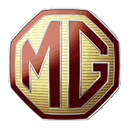Bono Estente. (I think I am going to leave that little bit of placeholder text right where it is, because it makes me smile. 10 bonus points if you can make the British Connection to the phrase.)
Anyway. Paint codes are an exciting, fun part of a British car restoration. Read that as a miserable, headache-inducing part of British car restoration.
Our beloved LBCs can be found painted with almost anything, from nitrocellulose enamel up to top-quality modern urethanes. Difficulties arise when we try to match original colors in our new paint families. When one goes into a modern automotive paint store with a color code from some time well before the catalytic converter, it will most likely not be of any help to the poor fellow behind the counter.
Lets take for example, British Racing Green. Everyone thinks they know BRG when they see it. "There! Look at that BRG sports car! I want that color!" as the little car zips past onto the freeway, never to be seen again. The problem starts when one tries to zero in on what British Racing Green it might be. I have no less than eight examples of BRG in my samples book, and those are only colors that I have actually shot test sheets for. MG changed its Racing Green over the years from pale and bright, to muddy and dark, to bland and simple, and that is not even taking into account production variances within of each color. Earlier cars would list only the name of the color, while later cars had numbered color codes. Jaguar had at least 5 shades, probably more, all called British Racing Green. Add in BRG made by MG, Triumph, Austin Healey, Bentley, Morris, etc, and you have a long list of colors, all called the same thing.
Even knowing exactly which one you want might not do much good. Perhaps, you want your paint guy to mix up some 1963 MGB Racing Green, which we happen to know is code GN-25. We can't buy original factory paint, it is no longer made. So we go into our local automotive paint store and ask our salesman what is available. Lets say this shop sells PPG paint. He can look in his old color books and find a color chip for that year, and we sill find that PPG has a formula, 43342, available in Delstar enamel. If that is the paint you want to shoot, you are in luck. However, Delstar is being slowly phased out, since it contains some fairly nasty ingredients. Local regulations might not even allow it to be sold in your area. He might recommend a new family of paint, such as DCC-Concept, a modern urethane. That Delstar formula number might cross-reference to a formula in Concept, or it might not. Keep in mind that the paint manufacturers are in the business of selling paint. The majority of their sales are going to be to body shops repairing collision damage to relatively recent cars. Thats where the money is. It is not in their best interest to reformulate every color ever made for every car ever made, every time a new family of paint comes out.
So, paint manufacturers keep what is called a color library. Our salesman will call the color library and ask for what is called an offset. Someone in the library will find a sample of the old paint formula and find a new paint sample that is very close, perhaps several samples. Sometimes this is computerized, sometimes they use old-fashioned eyeballs. The library will call the salesman back with these newer formulas and a description of how close the "offset" is. The offset might say, "slightly bluer" or "slightly darker". You have to decide whether that is close enough, or if you want to mix samples of these colors to shoot.
I never rely on color chips. I always shoot a color sample, if not on an actual panel, then on a full-sized sheet of photo paper. (Most brands of photo paper have coatings that are compatible with paint.) Look at the finished paint sample outside, in sunlight and in shade. Never make a color decision indoors. (You don't drive your car indoors.) The panel or the color sheet can be flexed and twisted, or taped to a fender, so that you can look at the paint with light from different angles, under direct and indirect sunlight. What might look perfect in the shade might show off its less obvious tints in direct sunlight, or vice versa.
If you are not happy with any of the sample shots, your only choice is custom mixing. If you know someone with the color you want, see if they will lend you a small panel to match. Find the oldest guy in the oldest paint store in the area, and he can probably mix what you want. It will take several days of mixing, test shooting and re-mixing. Or, go back to the source and flip through the color books back at the store and start over, mixing test samples as needed. I have had customers take several months to finally decide on a color. It might take me only a couple of hours to shoot the paint on a car, but the owners have to look at it for years and years. Its worth it to get it right.
